2. 上海海洋大学水产科学国家级实验教学示范中心, 上海 201306;
3. 上海海洋大学上海水产养殖工程技术研究中心, 上海 201306
2. National Demonstration Center for Experimental Fisheries Science Education, Shanghai Ocean University, Shanghai 201306, China;
3. Shanghai Engineering Research Center of Aquaculture; Shanghai Ocean University, Shanghai 201306, China
自然界中, 很多生物具有丰富的体色。体色的多样性不仅在物种进化中有着非常重要的生物学意义, 还能显著提高其经济价值。生物体色多样性受遗传和环境因素共同决定[1-2], 年龄、性别、健康状态和情感冲突等对其均有一定影响[3]。在不同体色黄鳝(Monopterus albus)、牙鲆(Paralichthys olivaceus)、莫桑比克罗非鱼(Oreochromis mossambicus)和红织雀(Foudia madagascariensis)的研究中表明:体色多样性与物种的生长、存活、择偶偏好等性状显著相关[4-7]。众所周知, 鱼类具有极其丰富的体色多样性。长期以来的生产和科学实践中, 鱼类这一特质一直被人们所开发和利用, 如日本锦鲤的培育、“江西三红”和瓯江彩鲤“龙申1号”等的选育, 都是国内外学者成功利用鱼类体色遗传规律与其生长等经济性状相关联而开发的鱼类新品种范例。
瓯江彩鲤(Cyprinius carpio var. color)是浙江省瓯江流域广泛养殖的一种地方性鲤科鱼类, 该鱼除生长迅速、抗逆性强、群体产量高、味道鲜美等突出的食用性能外, 还具有体色丰富、花纹艳丽等观赏性能, 是一个既可食用又可观赏的优良养殖对象。近20年来, 学者们先后对不同体色瓯江彩鲤的生长性能[8]、遗传变异[9-11]和抗病力[12-13]等进行了比较研究, 普遍发现各体色类型的生长性能存在明显差异, 其中“大花”和“粉花”体色类型的个体在增重率上具有较大优势[8, 14-15]。上述研究均表明, 不同体色瓯江彩鲤的生长性能存在一定差异, 表现出体色(质量性状)与生长(数量性状)的互作现象。然而, 迄今为止, 人们对于不同体色瓯江彩鲤生长差异的原因与机理尚不清楚, 其生长差异是否与消化生理特征, 如摄食率、呼吸代谢率以及相关消化酶的活性有关均未见相关报道。
因此, 本研究以同一家系的不同体色瓯江彩鲤为材料, 进行摄食节律、呼吸代谢以及相关消化酶的测定比较, 探讨不同体色瓯江彩鲤生长差异的消化和代谢基础, 既为揭示体色与生长互作现象提供行为和生理学方面的证据, 又为瓯江彩鲤的进一步的选育提供理论依据。
1 材料与方法 1.1 实验材料取上海海洋大学水产动物种质试验站(上海市浦东新区)同池饲养的源于1个家系的4种体色(“全红”WR、“大花”RB、“粉玉”WW、“粉花”WB)瓯江彩鲤1龄鱼种各30尾, 共120尾, 规格35~ 40 g/尾。实验鱼运至实验室后, 暂养于玻璃钢水族箱中(直径70 cm×高65 cm), 1周后开始正式实验。
1.2 生长比较正式实验期间, 取上述玻璃钢水族箱12只, 每只放养相同体色的试验鱼10尾, 每种体色类型设置3个重复。实验时间为2017年10月2日至11月30日, 共60 d。实验期间的各水族箱饲养管理一致, 水温维持在(23±0.5)℃。实验开始和结束时测量全部个体的体重(精确到0.1 g), 统计各体色类型的增重率, 具体公式如下:
绝对增重率AGR(g/d)=(Wt–W0)/d
特定增重率SGR(%/d)=(lnWt–lnW0)/d×100%
式中, W0、Wt分别为实验鱼开始和结束时的体重(g), d为实验天数。
1.3 摄食率比较在上述生长实验中, 每日的8:00和20:00分别投喂商用配合饲料, 投喂量为鱼体重的5%, 10 min后收集每个水族箱中的残饵量。结合相关文献报道[16-17], 根据预先统计该饲料50粒/g来计算每日的摄食量, 计算公式如下:
日摄食量FG(g)=(投喂饲料颗粒数–残余饲料颗粒数)×2.0/100
日摄食率FR(%)=FG/[(W0+Wt)/2]×100%
1.4 消化酶活性比较生长实验结束时, 随机选取4种体色瓯江彩鲤各10尾(共40尾), 进行尾静脉采血(预经ACD抗凝处理), 4000 r/min离心5 min, 取上清液。然后采用南京建成生物技术有限公司生产的胰蛋白酶(TSP)、脂肪酶(LPS)和α-淀粉酶(AMS)试剂盒, 进行3种消化酶的活性测定, 具体操作按说明书执行。
1.5 呼吸耗氧率比较呼吸耗氧率测定采用Loligo呼吸仪(Loligo®公司, 丹麦)进行。由于该仪器对实验鱼大小有较严格的要求, 因而另取试验站饲养的4种体色瓯江彩鲤幼鱼各10尾(共40尾), 规格(1.3~1.5) g/尾, 在实验室同样的水族箱中暂养1周后正式实验。测量前, 实验鱼停食24 h, 然后将每尾鱼放于仪器呼吸室, 在23℃水温条件下, 每10 min测定水体中溶氧含量, 连续测定12 h, 每尾鱼测定3轮次, 然后取平均值。最后利用仪器自带软件(AutoResp)计算该鱼的呼吸耗氧率。
1.6 数据处理与分析利用SPSS 20.0[18]软件对不同体色瓯江彩鲤的生长、摄食率、消化酶活性和呼吸耗氧率数据进行单因素方差分析、邓肯多重比较和相关性分析, 采用P < 0.05作为显著性临界值。
2 结果与分析 2.1 生长差异为期60 d的生长实验表明, “大花”体色瓯江彩鲤的绝对增重率和特定增重率均最高, 显著高于其他3种体色(P < 0.05), “粉花”和“全红”的特定增重率无显著差异(P > 0.05), 而“粉玉”的绝对增重率和特定增重率均显著低于其他体色(P < 0.05) (表 1)。
|
|
表 1 4种体色瓯江彩鲤的增重率差异 Tab.1 Growth rates differences in body weight of the four color patterns of Oujiang color common carp cyprinius carpio var. color |
实验期间, “大花”和“粉花”体色瓯江彩鲤的日摄食量显著高于“全红”和“粉玉”体色(P < 0.05), 而“大花”和“粉花”之间、“全红”和“粉玉”之间的日摄食量不存在显著差异(P > 0.05)。从日摄食率看, “大花”显著高于“全红”(P < 0.05), “粉玉”显著低于其他体色(P < 0.05)。总体上, 日摄食量和日摄食率差异顺序为“大花” > “粉花” > “全红” > “粉玉”(表 2)。
|
|
表 2 4种体色瓯江彩鲤的日摄食量和日摄食率 Tab.2 Daily feeding quantity and rate of the four color patterns of Oujiang color common carp cyprinius carpio var. color |
进一步分析白天和夜间的日摄食率发现, 4种体色瓯江彩鲤的白天摄食率均高于夜间, 其中“全红”和“大花”的白天与夜间摄食率差异显著(P < 0.05), 属于白天摄食类型; “粉玉”和“粉花”的白天与夜间摄食率无显著差异(P > 0.05), 属于无明显摄食节律型(图 1)。
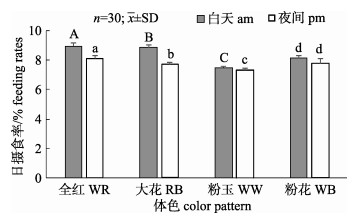
|
图 1 4种体色瓯江彩鲤昼夜摄食节律差异 同组字母不同表示差异显著(P < 0.05). RB:全红且有大黑点; WB2全白且有大黑点; WR:全红; WW:全白. Fig.1 Day and night feeding rhythm difference of the four color patterns of Oujiang color common carp cyprinius carpio var. color Different letters in the same group indicate significant differences (P < 0.05). RB: whole red with big black spots; WB: whole white with big black spots; WR: whole red; WW: whole white. |
4种体色瓯江彩鲤3种消化酶活力的测定结果表明(表 3), “全红”体色的脂肪酶(LPS)活性均高于其他3种体色, 其中与“粉玉”和“粉花”体色间的差异达到了显著水平(P < 0.05), “粉玉”体色的LPS活力最低。“大花”和“粉花”体色的胰蛋白酶(TSP)活性显著高于“全红”和“粉玉”体色(P < 0.01), “全红”和“粉玉”体色的TSP活性差异不大(P > 0.05)。4种体色的α-淀粉酶(AMS)活性不存在显著性差异(P > 0.05)。
|
|
表 3 4种体色瓯江彩鲤3种消化酶活性比较 Tab.3 Activities comparison of the three digestive enzymes in the four color patterns of Oujiang color common carp cyprinius carpio var. color |
通过每10 min对不同体色瓯江彩鲤的呼吸耗氧率测定发现, “粉玉”体色能最快达到静息呼吸状态(图 2)。在连续3次测定共12 h (共72个测定点)的平均呼吸耗氧率表明, “大花”的呼吸耗氧率最高[(109.75±6.61) mg O2/(kg·h)], “全红”次之[(98.74±3.49) mg O2/(kg·h)], 然后是“粉花” [(86.13±4.39 mg O2/(kg·h)), “粉玉”最低[(74.82± 2.83) mg O2/(kg·h)](图 3)。
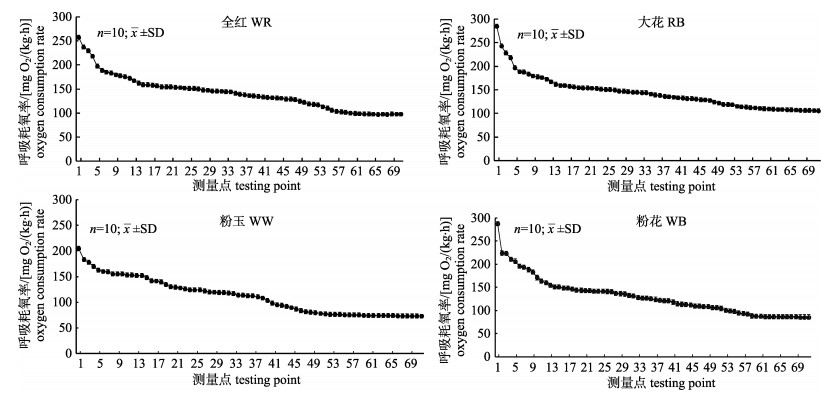
|
图 2 4种体色瓯江彩鲤在12 h内的呼吸耗氧率变化 Fig.2 Changes of real-time oxygen consumption rate of the four color patterns of Oujiang color common carp cyprinius carpio var. color measured during 12 h |
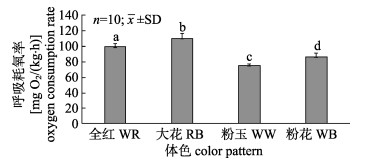
|
图 3 4种体色瓯江彩鲤实时呼吸耗氧率比较 各组字母不同表示差异显著(P < 0.05). Fig.3 Comparison of real-time oxygen consumption rate of the four color patterns of Oujiang color common carp cyprinius carpio var. color Different letters indicate significant differences (P < 0.05). |
将摄食率、消化酶活性与特定增重率分别作相关性分析的结果表明(图 4), 摄食率和胰蛋白酶活性分别与特定增重率呈极显著直线线性相关(P < 0.01, R2=0.2617; P < 0.01, R2=0.8233), 脂肪酶活性与特定增重率的相关性达到边缘显著性水平(P=0.056, R2=0.2832), 而α-淀粉酶活性与特定增重率无显著相关性(P > 0.05, R2=2×10-6)。
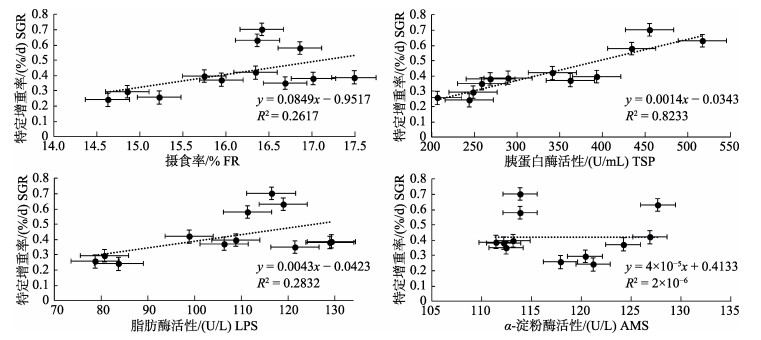
|
图 4 瓯江彩鲤摄食率、消化酶活性与特定增重率的相关性 Fig.4 Correlation between feeding rhythm, digestive enzyme activities and specific growth rate of body weight in Oujiang color common carp cyprinius carpio var. color |
进一步对摄食率与3种消化酶活性的相关性分析发现, 摄食率与脂肪酶活性呈极显著相关性(P < 0.01, R2=0.5111), 与胰蛋白酶活性呈显著相关性(P < 0.05, R2=0.7095), 而摄食率与α-淀粉酶活性无显著相关性(P > 0.05, R2=0.0076)(图 5)。
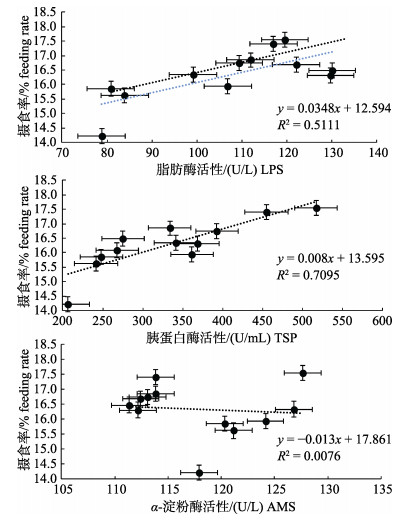
|
图 5 瓯江彩鲤摄食率与消化酶活性的相关性 Fig.5 Correlation between feeding rate and digestive enzyme activity in Oujiang color common carp cyprinius carpio var. color |
瓯江彩鲤体色丰富, 兼具食用与观赏性能, 是一个深受当地消费者喜欢的优良养殖对象。相关作者已报道了不同体色瓯江彩鲤的生长、遗传和抗病等方面的特性与差异[8-17]。早在2001年, 程起群等[14]报道瓯江彩鲤一龄阶段的绝对增重率和特定增重率均依次为“大花” > “麻花” > “粉花” > “全红” > “粉花”; 2004年, 王成辉等[8]的研究发现, “大花”在池塘养殖中的增重率最大, “粉花”的遗传—环境互作效应最大; 2013年, 朱丽艳[15]证实, “大花”和“粉花”两种体色瓯江彩鲤从一龄阶段起就表现出生长优势, 其生长显著快于其他3种体色(P < 0.05), “粉花”体色的生长速度最慢。本研究试图从其摄食行为、能量代谢和呼吸耗氧率等方面来探秘不同体色间差异。研究发现“大花”和“粉花”体色的绝对增重率和特定增重率均高于“全红”和“粉玉”, 特别是“大花”的增重率最显著, 再一次证明了瓯江彩鲤不同体色间的生长存在差异, 即带有大块黑色斑纹的“大花”和“粉花”的生长率要高于无黑色斑纹的“全红”和“粉玉”, 表现出体色(质量性状)与生长(数量性状)互作效应。该研究结果也进一步表明, 不同体色间的生长差异是具有其相应的遗传和生理特性的。
摄食行为是动物与生俱来的能力, 也是机体能量代谢的主要过程。鱼类通过摄食获得生长、发育、繁殖以及种群进化所需的能量, 并逐渐形成一系列与之相关的生理生化以及行为生态学方面的适应特征[19-22]。在本研究中, 不同体色类型的瓯江彩鲤在日摄食量和日摄食率上体现出明显差异, 其中体表带有大块黑斑的“大花”和“粉花”体色类型个体表现尤为突出, 这与不同体色类型的生长差异相符合, 即“大花”和“粉花”通过摄食更多的食物来支撑其更快的生长。通过分析不同体色的昼夜摄食差异, 还发现另一个有意思的现象:具有红色体色的“大花”和“全红”瓯江彩鲤的白天摄食率显著高于夜间, 而具有白色体色的“粉玉”和“粉花”瓯江彩鲤白天与夜间的摄食率却无显著差异(P > 0.05)。这种红色体色所表现出来的昼夜摄食差异, 是否与红色体色的调控通路有关, 还有待下一步的研究。进一步分析代表性消化酶(脂肪酶、蛋白酶以及淀粉酶)的活性发现, 不同体色类型个体脂肪酶活性有一些差异, 淀粉酶活性基本相同, 但在蛋白酶活性上存在显著差异, 尤其是“大花”和“粉花”体色类型表现突出, 这与不同体色类型的摄食和生长差异规律相一致, 说明鱼类的摄食量高, 其蛋白酶活性也相应增高, 这与周兴华[23]报道的“同一食性鱼类, 蛋白酶活性强弱与摄食能力成正相关”结论一致。苏艳丽等[24]也指出鱼类的更快生长需要提高摄食量和摄食率来支撑, 而摄食量和摄食率的提高也增强了其体内的蛋白酶和脂肪酶活性。该研究结果表明, 部分消化酶与摄食和生长性能间存在较高相关性, 其中“大花”和“粉花”体色瓯江彩鲤的更快生长速度来源其更强的摄食性和更高的蛋白酶和脂肪酶活性。
鱼类的生长发育全过程都和氧的利用息息相关, 鱼类耗氧率的大小及变化就能体现其代谢水平的高低以及变化规律[25-26]。本研究中, 4种体色瓯江彩鲤的呼吸耗氧率均存在显著差异(P < 0.05)。就整体而言, 发现红色体色的呼吸耗氧率高于白色体色, 可以认为呼吸耗氧率高的个体表现出摄食率更高、生长速度更快。张曦等[27]的研究也表明较高标准代谢率的鲤幼鱼个体表现较高的活跃性和较强的摄食代谢能力。但是, 本研究发现耗氧率的变化趋势与生长和摄食率的差异规律整体趋势相似但并非完全一致, 分析认为鱼类呼吸效率也受到个体大小、应激、鱼体健康状况等诸多因素影响有关[28-29]。此外, 在研究过程中运用了数字化的Loligo呼吸测定系统, 相较于传统的流水式呼吸室[30]测定耗氧率的方法, 具有精确程度更高和可控性更强等特点, 可为其他鱼类的呼吸耗氧率测定提供参考。
| [1] |
Xu W, Tong G X, Geng L W, et al. Body color development and genetic analysis of hybrid transparent crucian carp (Carassius auratus)[J]. Genetics & Molecular Research, 2015, 14(2): 4399-4407. |
| [2] |
Tave D, Rezk M, Smitherman R O. Genetics of body color in Tilapia mossambica[J]. Journal of the World Aquaculture Society, 2010, 20(4): 214-222. |
| [3] |
Wang X L, Wang X J. Research on vertebrate body color[J]. Journal of Jilin Agricultural Science and Technology College, 2006, 15(1): 15-17. [王晓玲, 王信军. 脊椎动物体色的研究[J]. 吉林农业科技学院学报, 2006, 15(1): 15-17.] |
| [4] |
Chen F, Yang D Q, Su Y B. Comparison of growth rate of three different body color Monopterus albus[J]. Journal of Yangtze University (Natural Science Edition Agriculture Science Volumn), 2009, 6(3): 33-34. [陈芳, 杨代勤, 苏应兵. 3种不同体色黄鳝生长速度的比较[J]. 长江大学学报(自然科学版):农学卷, 2009, 6(3): 33-34.] |
| [5] |
Shikano T. Marker-based estimation of heritability for body color variation in Japanese flounder Paralichthys olivaceus[J]. Aquaculture, 2005, 249(1-4): 95-105. DOI:10.1016/j.aquaculture.2005.03.023 |
| [6] |
Gong C P. The growth performance comparison and genetic diversity analysis of different body color red tilapia[D]. Nanjing: Nanjing Agricultural University, 2015. [公翠萍.不同体色红罗非鱼生长性能比较及遗传多样性研究[D].南京: 南京农业大学, 2015.] http://www.wanfangdata.com.cn/details/detail.do?_type=degree&id=Y3184938
|
| [7] |
Estep L K, Shawkey M D, Hill G E. Carotenoid-based breast plumage color, body condition and clutch size in red fodies (Foudia madagascariensis)[J]. Ostrich, 2006, 77(3-4): 164-169. DOI:10.2989/00306520609485528 |
| [8] |
Wang C H, Li S F, Zeng W G, et al. Genotype-environment interaction analysis from the body color and growth character in Oujiang color common carp, Cyprinus carpio var. color[J]. Journal of Shanghai Fisheries University, 2004, 13(2): 103-106. [王成辉, 李思发, 曾伟光. 瓯江彩鲤体色与生长的遗传一环境互作分析[J]. 上海水产大学学报, 2004, 13(2): 103-106.] |
| [9] |
Lv Y P, Hu Z H, Xiao J Z, et al. Intraspecific DNA sequence polymorphism genetic markers in the mitochondrial COII gene from five color patterns of Oujaing color carp[J]. Journal of Zhejiang University (Science Edition), 2009, 36(3): 323-327. [吕耀平, 胡则辉, 肖建中, 等. 5种体色瓯江彩鲤线粒体COII基因的序列差异和遗传标记研究[J]. 浙江大学学报(理学版), 2009, 36(3): 323-327. DOI:10.3785/j.issn.1008-9497.2009.03.018] |
| [10] |
Wang C H, Li S F, Xiang S P, et al. Genetic parameter estimates for growth-related traits in Oujiang color common carp (Cyprinus carpio var. color)[J]. Aquaculture, 2006, 259(1-4): 103-107. DOI:10.1016/j.aquaculture.2006.05.031 |
| [11] |
Wang C H, Xiang S P, Lv Y P, et al. Preliminary study on inheritance of red and white color phenotypes in Oujiang color carp, Cyprinus carpio var. color[J]. Journal of Shanghai Fisheries University, 2008, 17(4): 402-405. [王成辉, 项松平, 吕耀平, 等. 瓯江彩鲤红、白两种体色遗传关系的初步研究[J]. 上海水产大学学报, 2008, 17(4): 402-405.] |
| [12] |
Zhao X J, Liu Z Z, Li X S, et al. Major histocompatibility complex class Ⅱ B allele polymorphism and its association with resistance/susceptibility to Aeromonas hydrphila in the "whole white" color patterns of Cyprinus carpio var. color[J]. Journal of Fishery Sciences of China, 2012, 19(3): 399-407. [赵雪锦, 刘至治, 李雪松, 等. "粉玉"体色瓯江彩鲤MHC class Ⅱ B基因多态性及其与鱼体抗病力的关系[J]. 中国水产科学, 2012, 19(3): 399-407.] |
| [13] |
Li X S, Liu Z Z, Zhao X J, et al. Major histocompatibility complex DAB allele polymorphism and its association with resistance/susceptibility to Aeromonas hydrophila in "whole red" color patterns of Cyprinus carpio var. color[J]. Journal of Fisheries of China, 2011, 35(9): 1293-1301. [李雪松, 刘至治, 赵雪锦, 等. "全红"体色瓯江彩鲤MHC-DAB基因多态性及其与鱼体抗病力关系的分析[J]. 水产学报, 2011, 35(9): 1293-1301.] |
| [14] |
Cheng Q Q, Wang C H, Li S F, et al. The studies of variations of growth rate and survival rate of different pigmentation types of color common carp[J]. Fisheries Science & Technology Information, 2001, 28(2): 56-58. [程起群, 王成辉, 李思发, 等. 不同体色瓯江彩鲤生长率和存活率的差异研究[J]. 水产科技情报, 2001, 28(2): 56-58. DOI:10.3969/j.issn.1001-1994.2001.02.004] |
| [15] |
Zhu L Y. Genetic effects analysis on growth and physiological traits in the complete set lines of Oujiang color common carp (Cyprinus carpio var. color)[D]. Shanghai: Shanghai Ocean University, 2013. [朱丽艳.瓯江彩鲤配套选育系生长和生理性状的遗传效应研究[D].上海: 上海海洋大学, 2013.] http://www.wanfangdata.com.cn/details/detail.do?_type=degree&id=D372805
|
| [16] |
Yang R B, Xie C X, Wei K J, et al. The daily feeding rhythms of juvenile yellow catfish, Pelteobagrus fulvidraco at different feeding frequencies[J]. Journal of Huazhong Agricultural University, 2006, 25(3): 274-276. [杨瑞斌, 谢从新, 魏开建, 等. 不同投喂频率下黄颡鱼幼鱼的摄食节律研究[J]. 华中农业大学学报, 2006, 25(3): 274-276. DOI:10.3321/j.issn:1000-2421.2006.03.014] |
| [17] |
Li S F. Freshwater Fish Population Ecology[M]. Beijing: Agriculture Press, 1990. [李思发. 淡水鱼类种群生态学[M]. 北京: 农业出版社, 1990.]
|
| [18] |
Huizingh E. Inleiding SPSS 20.0 voor IBM SPSS Statistics[M]. Academic Service, 2012.
|
| [19] |
Fu S J, Cao Z D, Xie X J. Feeding metabolism and locomotion metabolism in fishes[J]. Chinese Journal of Zoology, 2008, 43(2): 150-159. [付世建, 曹振东, 谢小军. 鱼类摄食代谢和运动代谢研究进展[J]. 动物学杂志, 2008, 43(2): 150-159. DOI:10.3969/j.issn.0250-3263.2008.02.028] |
| [20] |
Fu S J, Xie X J, Cao Z D. Effect of fasting and repeat feeding on metabolic rate in southern catfish, Silurus Meridionalis Chen[J]. Marine and Freshwater Behaviour and Physiology, 2005, 38(3): 191-198. DOI:10.1080/10236240500231532 |
| [21] |
Fu S J, Cao Z D. Effect of dietary protein and lipid levels on feed intake and growth performance of southern catfish, Silurus Meridionalis Chen[J]. Aquaculture Research, 2006, 37(1): 107-110. DOI:10.1111/are.2006.37.issue-1 |
| [22] |
Yamamoto T, Konishi K, Shima T, et al. Influence of dietary fat and carbohydrate levels on growth and body composition of rainbow trout Oncorhynchus Mykiss under self-feeding conditions[J]. Fisheries Science, 2010, 67(2): 221-227. |
| [23] |
Zhou X H. Comparison of digestive enzyme activities of three famous fish species[J]. Guangdong Feed, 2003, 12(6): 19-21. [周兴华. 三种名优鱼类消化酶活性的比较[J]. 广东饲料, 2003, 12(6): 19-21. DOI:10.3969/j.issn.1005-8613.2003.06.012] |
| [24] |
Su Y L, Ge X P, Sun S M, et al. Effects of compensatory feeding after starvation on growth performance, serum biochemical indexes, intestinal digestive enzyme activity and hepatic antioxidant enzyme activities of juvenile blunt snout bream (Megalobrama amblycephal) in summer[J]. Chinses Journal of Animal Nutrition, 2017, 29(11): 4198-4206. [苏艳莉, 戈贤平, 孙盛明, 等. 高温季节饥饿后补偿摄食对团头鲂幼鱼生长性能、血清生化指标、肠道消化酶活性及肝脏抗氧化酶活性的影响[J]. 动物营养学报, 2017, 29(11): 4198-4206. DOI:10.3969/j.issn.1006-267x.2017.11.044] |
| [25] |
Feng X, Chen P M, Qin C X. Advancement of the study on respiratory metabolism of fishery resource organism[J]. Guangdong Agricultural Sciences, 2012, 39(4): 92-96. [冯雪, 陈丕茂, 秦传新. 渔业资源生物呼吸代谢研究进展[J]. 广东农业科学, 2012, 39(4): 92-96. DOI:10.3969/j.issn.1004-874X.2012.04.033] |
| [26] |
Chen S B, Chen W X, Fan Z T. Advancement of the study on respiratory metabolism of fishes[J]. Chinese Journal of Fisheries, 2004, 17(1): 82-89. [陈松波, 陈伟兴, 范兆廷. 鱼类呼吸代谢研究进展[J]. 水产学杂志, 2004, 17(1): 82-89. DOI:10.3969/j.issn.1005-3832.2004.01.018] |
| [27] |
Zhang X, Zeng L Q, Fu S J, et al. Intraspecific differences in standard metabolic rate and its correlations with locomotion and feeding metabolism in juvenile common carp (Cyprinus carpio)[J]. Chinese Journal of Zoology, 2016, 51(3): 384-394. [张曦, 曾令清, 付世建, 等. 鲤幼鱼标准代谢率的个体差异与运动性能和摄食代谢的关系[J]. 动物学杂志, 2016, 51(3): 384-394.] |
| [28] |
Li J E, Cao S H, Ou Y J, et al. Influence of temperature, salinity, and pH on oxygen consumption rate, ammonia excretion rate, and suffocation point in juvenile Mugil cephalus[J]. Journal of Fishery Sciences of China, 2014, 21(5): 954-962. [李加儿, 曹守花, 区又君, 等. 温度、盐度和pH对鲻幼鱼耗氧率、排氨率以及窒息点的影响[J]. 中国水产科学, 2014, 21(5): 954-962.] |
| [29] |
Du J S, Gao P, Liu L Z, et al. Effects of water temperature, body weight, feeding state and photoperiod on oxygen consumption rate of Esox lucius[J]. Freshwater Fisheries, 2011, 41(4): 45-49. [杜劲松, 高攀, 刘立志, 等. 温度、体重、摄食和光照对白斑狗鱼幼鱼耗氧率的影响[J]. 淡水渔业, 2011, 41(4): 45-49. DOI:10.3969/j.issn.1000-6907.2011.04.008] |
| [30] |
Song S X, Liu H B, Sun D J, et al. The asphyxiation point and oxygen consumption rate of acipenser schrencki[J]. Journal of Fishery Sciences of China, 1997, 4(5): 100-103. [宋苏祥, 刘洪柏, 孙大江, 等. 史氏鲟稚鱼的耗氧率和窒息点[J]. 中国水产科学, 1997, 4(5): 100-103. DOI:10.3321/j.issn:1005-8737.1997.05.019] |
 2019, Vol. 26
2019, Vol. 26

